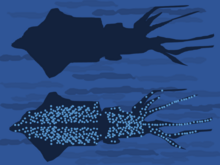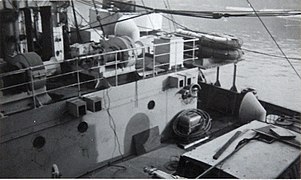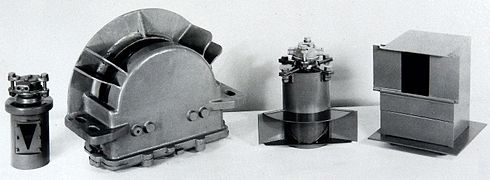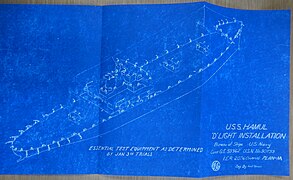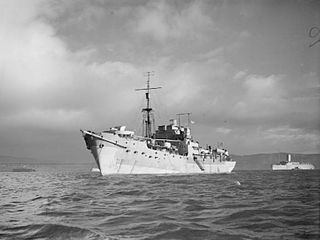
HMS Largs was a former Compagnie Generale Transatlantique fruit (banana) ship captured by the Royal Navy ship HMS Faulknor five months after the Battle of France while docked at Gibraltar in November 1940 and commissioned as an "ocean boarding vessel". She subsequently became a Combined Operations Headquarters ship for almost every significant amphibious operation of World War II, including Operations Torch, Husky and Overlord and she would be manned by naval, army and air force crew.

The Flower-class corvette was a British class of 294 corvettes used during World War II by the Allied navies particularly as anti-submarine convoy escorts in the Battle of the Atlantic. Royal Navy ships of this class were named after flowers.
HMS Audacity was a British escort carrier of the Second World War and the first of her kind to serve in the Royal Navy. She was originally the German merchant ship Hannover, which the British captured in the West Indies in March 1940 and renamed Sinbad, then Empire Audacity. She was converted and commissioned as HMS Empire Audacity, then as HMS Audacity. She was torpedoed and sunk by a German U-boat in late 1941.

The Castle-class corvette was an ocean going convoy escort developed by the United Kingdom during the Second World War. It was the follow-on to the Flower-class corvette, and designed to be built in shipyards that were producing the Flowers. The Castle-class was a general improvement over the smaller Flowers which were designed for coastal rather than open ocean use.
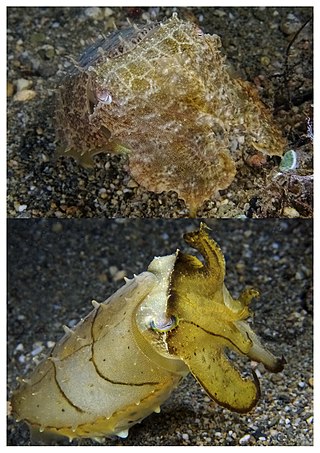
Active camouflage or adaptive camouflage is camouflage that adapts, often rapidly, to the surroundings of an object such as an animal or military vehicle. In theory, active camouflage could provide perfect concealment from visual detection.
In the Royal Navy and other navies of Europe and the Commonwealth of Nations, ships are identified by pennant number. Historically, naval ships flew a flag that identified a flotilla or type of vessel. For example, the Royal Navy used a red burgee for torpedo boats and a pennant with an H for torpedo boat destroyers. Adding a number to the type-identifying flag uniquely identified each ship.

Yehudi lights are lamps of automatically controlled brightness placed on the front and leading edges of an aircraft to raise the aircraft's luminance to the average brightness of the sky, a form of active camouflage using counter-illumination. They were designed to camouflage the aircraft by preventing it from appearing as a dark object against the sky.

The River class was a class of 151 frigates launched between 1941 and 1944 for use as anti-submarine convoy escorts in the North Atlantic. The majority served with the Royal Navy and Royal Canadian Navy (RCN), with some serving in the other Allied navies: the Royal Australian Navy (RAN), the Free French Naval Forces, the Royal Netherlands Navy and, post-war, the South African Navy.

Dazzle camouflage, also known as razzle dazzle or dazzle painting, is a family of ship camouflage that was used extensively in World War I, and to a lesser extent in World War II and afterwards. Credited to the British marine artist Norman Wilkinson, though with a rejected prior claim by the zoologist John Graham Kerr, it consisted of complex patterns of geometric shapes in contrasting colours interrupting and intersecting each other.
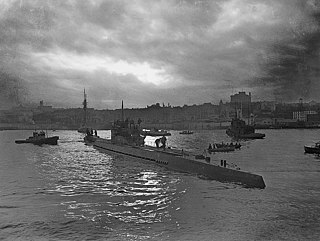
The Battle of the St. Lawrence involved marine and anti-submarine actions throughout the lower St. Lawrence River and the entire Gulf of Saint Lawrence, Strait of Belle Isle, Anticosti Island and Cabot Strait from May–October 1942, September 1943, and again in October–November 1944. During this time, German U-boats sank over 20 merchant ships and four Canadian warships. There were several near-shore actions involving the drop of German spies, or the attempted pickup of escaping prisoners of war. Despite the 23 ships lost, this battle marked a strategic victory for Canadian forces as ultimately they managed to disrupt U-boat activity, protect Canadian and Allied convoys, and intercept all attempted shore operations. This marked the first time that a foreign power had inflicted casualties in Canadian inland waters since the US incursions in the War of 1812.

The Department of Miscellaneous Weapons Development (DMWD), also known as the Directorate of Miscellaneous Weapon Development and colloquially known as the Wheezers and Dodgers, was a department of the British Admiralty responsible for the development of various unconventional weapons during World War II.

Ship camouflage is a form of military deception in which a ship is painted in one or more colors in order to obscure or confuse an enemy's visual observation. Several types of marine camouflage have been used or prototyped: blending or crypsis, in which a paint scheme attempts to hide a ship from view; deception, in which a ship is made to look smaller or, as with the Q-ships, to mimic merchantmen; and dazzle, a chaotic paint scheme which tries to confuse any estimate of distance, direction, or heading. Counterillumination, to hide a darkened ship against the slightly brighter night sky, was trialled by the Royal Canadian Navy in diffused lighting camouflage.

HMCS Cobalt was a Flower-class corvette of the Royal Canadian Navy which took part in convoy escort duties during the Second World War. She served primarily in the Battle of the Atlantic. She was named for Cobalt, Ontario.
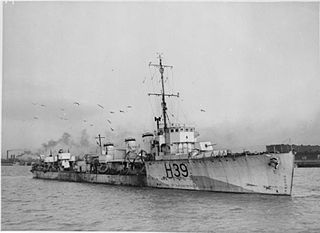
An Escort Group consisted of several small warships organized and trained to operate together protecting trade convoys. Escort groups were a World War II tactical innovation in anti-submarine warfare by the Royal Navy to combat the threat of the Kriegsmarine's "wolfpack" tactics. Early escort groups often contained destroyers, sloops, naval trawlers and, later, corvettes of differing specifications lacking the ability to maneuver together as a flotilla of similar warships, but rigorously trained in anti-submarine tactics to use teamwork emphasizing the unique sensors, weapons, speed, and turning radius of each ship. The development of these 'escort groups' proved an effective means of defending shipping convoys through the Battle of the Atlantic.

HMCS Kamloops was a Flower-class corvette that served in the Royal Canadian Navy during the Second World War. She served primarily in the Battle of the Atlantic as an ocean escort. She was named for Kamloops, British Columbia.

Counter-illumination is a method of active camouflage seen in marine animals such as firefly squid and midshipman fish, and in military prototypes, producing light to match their backgrounds in both brightness and wavelength.

HMCS Chambly was a Flower-class corvette serving in the Royal Canadian Navy. She was ordered from Canadian Vickers Ltd. in Montreal, laid down on 20 February 1940, launched on 29 July, and commissioned on 18 December 1940, named after the city of Chambly, Quebec. Chambly escorted trade convoys between Halifax Harbour and the Western Approaches through the battle of the Atlantic and, together with HMCS Moose Jaw, achieved the RCN's first U-boat kill of the war.

HMCS St. Catharines was a River-class frigate that served with the Royal Canadian Navy during the Second World War. She served primarily as a convoy escort in the Battle of the Atlantic. She was named for St. Catharines, Ontario. After the war she was re-purposed as a weather ship for use by the Department of Transport of Canada.
HMS Teme was a River-class frigate of the Royal Navy that was built during the Second World War. The frigate was named for the River Teme, a river that flows along the English-Welsh border. She was transferred to the Royal Canadian Navy and served as HMCS Teme. She was torpedoed by a German submarine on 29 March 1945 and subsequently declared a constructive total loss. The ship was broken up in Wales in 1946.

HMS Alisma was a Flower-class corvette that served in the Royal Navy.


